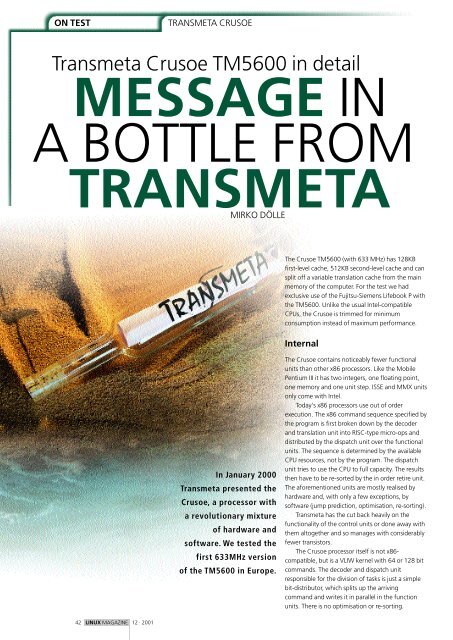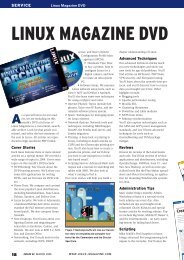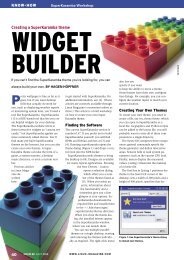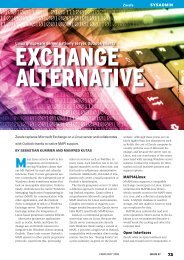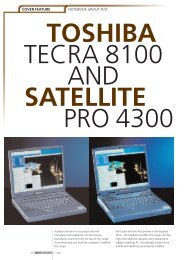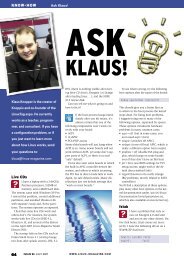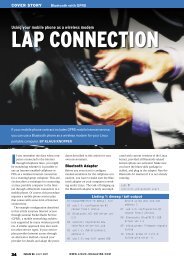Transmeta Crusoe TM5600 in detail - Linux Magazine
Transmeta Crusoe TM5600 in detail - Linux Magazine
Transmeta Crusoe TM5600 in detail - Linux Magazine
You also want an ePaper? Increase the reach of your titles
YUMPU automatically turns print PDFs into web optimized ePapers that Google loves.
ON TEST TRANSMETA CRUSOE<br />
<strong>Transmeta</strong> <strong>Crusoe</strong> <strong>TM5600</strong> <strong>in</strong> <strong>detail</strong><br />
MESSAGE IN<br />
A BOTTLE FROM<br />
TRANSMETA<br />
MIRKO DÖLLE<br />
42 LINUX MAGAZINE 12 · 2001<br />
In January 2000<br />
<strong>Transmeta</strong> presented the<br />
<strong>Crusoe</strong>, a processor with<br />
a revolutionary mixture<br />
of hardware and<br />
software. We tested the<br />
first 633MHz version<br />
of the <strong>TM5600</strong> <strong>in</strong> Europe.<br />
The <strong>Crusoe</strong> <strong>TM5600</strong> (with 633 MHz) has 128KB<br />
first-level cache, 512KB second-level cache and can<br />
split off a variable translation cache from the ma<strong>in</strong><br />
memory of the computer. For the test we had<br />
exclusive use of the Fujitsu-Siemens Lifebook P with<br />
the <strong>TM5600</strong>. Unlike the usual Intel-compatible<br />
CPUs, the <strong>Crusoe</strong> is trimmed for m<strong>in</strong>imum<br />
consumption <strong>in</strong>stead of maximum performance.<br />
Internal<br />
The <strong>Crusoe</strong> conta<strong>in</strong>s noticeably fewer functional<br />
units than other x86 processors. Like the Mobile<br />
Pentium III it has two <strong>in</strong>tegers, one float<strong>in</strong>g po<strong>in</strong>t,<br />
one memory and one unit step. ISSE and MMX units<br />
only come with Intel.<br />
Today's x86 processors use out of order<br />
execution. The x86 command sequence specified by<br />
the program is first broken down by the decoder<br />
and translation unit <strong>in</strong>to RISC-type micro-ops and<br />
distributed by the dispatch unit over the functional<br />
units. The sequence is determ<strong>in</strong>ed by the available<br />
CPU resources, not by the program. The dispatch<br />
unit tries to use the CPU to full capacity. The results<br />
then have to be re-sorted by the <strong>in</strong> order retire unit.<br />
The aforementioned units are mostly realised by<br />
hardware and, with only a few exceptions, by<br />
software (jump prediction, optimisation, re-sort<strong>in</strong>g).<br />
<strong>Transmeta</strong> has the cut back heavily on the<br />
functionality of the control units or done away with<br />
them altogether and so manages with considerably<br />
fewer transistors.<br />
The <strong>Crusoe</strong> processor itself is not x86compatible,<br />
but is a VLIW kernel with 64 or 128 bit<br />
commands. The decoder and dispatch unit<br />
responsible for the division of tasks is just a simple<br />
bit-distributor, which splits up the arriv<strong>in</strong>g<br />
command and writes it <strong>in</strong> parallel <strong>in</strong> the function<br />
units. There is no optimisation or re-sort<strong>in</strong>g.
Software/ hardware mix<br />
To run x86 programs on the <strong>Crusoe</strong>, there has to be<br />
a translation <strong>in</strong>to the VLIW command set of the<br />
<strong>Crusoe</strong>. This is done by the code-morph<strong>in</strong>g<br />
software, which L<strong>in</strong>us Torvalds was heavily <strong>in</strong>volved<br />
<strong>in</strong> develop<strong>in</strong>g. This is loaded from the flash, which<br />
can be updated, <strong>in</strong>to one part of the translation<br />
cache. In addition to translation, the software is<br />
responsible for the optimisation of the code up to<br />
the out of order execution, packs the result <strong>in</strong> bitesize<br />
chunks <strong>in</strong>to VLI words and saves it <strong>in</strong> the<br />
translation cache.<br />
The concept is similar to the FX32 expansion of<br />
Digital for W<strong>in</strong>dows NT and L<strong>in</strong>ux, which allows the<br />
execution of x86 programs on Alpha CPUs and<br />
saves the translation result created dur<strong>in</strong>g the run<br />
time <strong>in</strong> a shadow file on the hard drive.<br />
It takes a lot longer to translate the commands<br />
with the code morph<strong>in</strong>g software than <strong>in</strong> the<br />
Decoder-Unit of the Pentium III. But unlike an<br />
almost purely hardware solution, considerably<br />
larger algorithms can be used. If the same<br />
command block comes up aga<strong>in</strong> for execution, the<br />
VLIW commands are supplied straight from the<br />
translation cache, without be<strong>in</strong>g retranslated.<br />
Midori L<strong>in</strong>ux<br />
The <strong>Transmeta</strong> <strong>Crusoe</strong> is suitable as an<br />
extremely energy-economical processor<br />
especially for mobile PCs. Its ma<strong>in</strong><br />
application is <strong>in</strong> the doma<strong>in</strong> of notebooks,<br />
which need a high-performance x86compatible<br />
CPU us<strong>in</strong>g as little energy as<br />
possible. What matters is that the operat<strong>in</strong>g<br />
system exploits the energy-sav<strong>in</strong>g abilities<br />
of the hardware.<br />
L<strong>in</strong>ux doesn't offer stable support for<br />
ACPI power management yet. And L<strong>in</strong>ux<br />
systems are comparatively large – with a<br />
graphical user <strong>in</strong>terface and browser they<br />
come to over 128MB.<br />
Lean and mean<br />
<strong>Transmeta</strong> has taken this problem on board<br />
and is present<strong>in</strong>g Midori L<strong>in</strong>ux, which has<br />
optimal slimness and support for power<br />
management. <strong>Transmeta</strong> does not supply any<br />
complete b<strong>in</strong>ary packages, so the distribution<br />
<strong>in</strong> the version to which we had access (version<br />
1.0.0-beta2), consists of a tar archive with<br />
Web-based configuration front end.<br />
The Midori program packages are tarballs<br />
equipped with additional <strong>in</strong>formation with<br />
the end<strong>in</strong>g mlz. After configuration the<br />
whole system is compiled us<strong>in</strong>g Cross-<br />
Compiler and then written as a hard disk<br />
One for all<br />
TRANSMETA CRUSOE<br />
The <strong>Crusoe</strong> <strong>TM5600</strong> can be seen on the right with<br />
the south bridge and ATI graphics chips to the left<br />
The encapsulation of the entire hardware by code<br />
morph<strong>in</strong>g software opens up some completely new<br />
possibilities. So the VLIW kernel of the processor<br />
image <strong>in</strong>clud<strong>in</strong>g partition<strong>in</strong>g onto a block<br />
device. Red Hat 6.2 is suitable for the<br />
compilation, while the help scripts failed on<br />
more recent Red Hat and SuSE releases.<br />
You should allow a few<br />
hours and sufficient space<br />
on the hard disk for the<br />
first compilation because<br />
by the time you f<strong>in</strong>ish,<br />
sources, objects and<br />
b<strong>in</strong>ary packets will take up<br />
a good 1.6GB.<br />
Midori <strong>in</strong> practice<br />
We were unable to get<br />
Midori to run completely on<br />
the Fujitsu-Siemens Lifebook P,<br />
as XFree86 4.0.1 simply could not<br />
come to terms with the unusual<br />
display. The kernel on the other<br />
hand ran stably with ACPI. An<br />
application test was thus not<br />
possible, as there are no console tools.<br />
Midori is at present <strong>in</strong>tended only for<br />
developers of mobile PCs; it is not a userdistribution.<br />
But due to the work<strong>in</strong>g power<br />
management and small size it is noticeably<br />
more suitable for portable applications than<br />
standard systems.<br />
12 · 2001 LINUX MAGAZINE 43<br />
ON TEST
ON TEST TRANSMETA CRUSOE<br />
44 LINUX MAGAZINE 12 · 2001<br />
can be changed at will at any time, as happened<br />
with TM3200 and TM5400. Bugfixes or<br />
fundamental function changes are no problem. The<br />
x86 upwards-compatibility is reta<strong>in</strong>ed, only the code<br />
morph<strong>in</strong>g software has to be adapted.<br />
Emulation of other CPU architectures is also<br />
possible, so there is a Java version of the codemorph<strong>in</strong>g<br />
software. This is <strong>in</strong>terest<strong>in</strong>g for the<br />
development of new processors. It is possible to<br />
test the command set or develop software on<br />
very powerful, <strong>Crusoe</strong>-based development<br />
systems long before the first<br />
processor prototype.<br />
So <strong>Transmeta</strong> has built a <strong>Crusoe</strong> with<br />
Clawhammer emulation for AMD, which is already<br />
<strong>in</strong> use. And the emulation of completely different<br />
architectures such as Power-PC or RISC is also<br />
possible, although their performance is limited by<br />
the VLIW hardware.<br />
<strong>Transmeta</strong> has achieved additional energy<br />
sav<strong>in</strong>gs with the Longrun power management. So<br />
the code morph<strong>in</strong>g software dynamically adjusts the<br />
kernel voltage and the clock frequency can be<br />
reduced smoothly to 300MHz. This makes the<br />
<strong>Crusoe</strong> markedly different from Intel's Speed Step,<br />
which has only three stages.<br />
By <strong>in</strong>tegrat<strong>in</strong>g the north bridge <strong>in</strong>to the CPU the<br />
<strong>Crusoe</strong> <strong>TM5600</strong> can separate off part of the ma<strong>in</strong><br />
memory as translation cache and saves space on the<br />
PCB.<br />
High <strong>in</strong>tegration<br />
An additional advantage is that of the <strong>in</strong>tegration of<br />
the north bridge <strong>in</strong>to the <strong>Crusoe</strong>, which is also<br />
trimmed for m<strong>in</strong>imal power consumption. In all the<br />
<strong>Crusoe</strong> consumes, at a kernel voltage of 1.4V, a<br />
maximum of 2.9W <strong>in</strong>clud<strong>in</strong>g north bridge, a Mobile<br />
Pentium III comes <strong>in</strong> at a m<strong>in</strong>imum of 5W plus 2 to<br />
3W for the north bridge.<br />
At the same time, the <strong>Crusoe</strong> – with the same<br />
structural size (18 millimetres) – is about a quarter<br />
smaller than Intel's Mobile Pentium III. As more<br />
chips fit onto one wafer, production gets cheaper.<br />
One other plus po<strong>in</strong>t is the space saved, so now<br />
essentially only three chips are now needed for a<br />
complete PC. ■<br />
Fujitsu-Siemens Lifebook P<br />
with <strong>Crusoe</strong> <strong>TM5600</strong><br />
READY FOR<br />
THE ISLAND<br />
MIRKO DÖLLE<br />
The <strong>Transmeta</strong> <strong>Crusoe</strong><br />
boosts the Fujitsu-<br />
Siemens Lifebook P to a<br />
phenomenal battery life<br />
of well over six hours.<br />
L<strong>in</strong>ux Magaz<strong>in</strong>e has<br />
tested the new subnotebook,<br />
which comes<br />
out <strong>in</strong> October.<br />
The Lifebook P stands out because of its unusual<br />
hardware. The <strong>Transmeta</strong> <strong>Crusoe</strong> <strong>TM5600</strong> has<br />
633MHz and just a 10.1-<strong>in</strong>ch display with<br />
1280x600 pixels at 140 dpi – which is more than<br />
many <strong>in</strong>kjet pr<strong>in</strong>ters can get onto paper. The preseries<br />
model tested will be available <strong>in</strong> this format<br />
from October <strong>in</strong> all major electronics stores, but the<br />
price has not yet been fixed.<br />
Of the 128MB RAM, 16MB is set aside for the<br />
translation cache of the <strong>Crusoe</strong>, and an expansion<br />
with standard SO-DIMMs is not possible. On the<br />
15GB hard drive, it is planned to pre-<strong>in</strong>stall<br />
W<strong>in</strong>dows Me, but delivery with L<strong>in</strong>ux is currently<br />
flounder<strong>in</strong>g due to the lack of support for the<br />
modem and the control buttons for the DVD player<br />
built <strong>in</strong> below the display.
Run-time giant with multimedia<br />
The Lifebook P is <strong>in</strong>tended as a m<strong>in</strong>i-multimedia<br />
mach<strong>in</strong>e, comb<strong>in</strong><strong>in</strong>g MP3, CD and DVD player <strong>in</strong><br />
one and also offer<strong>in</strong>g the functionality of a standard<br />
PC. With a battery life of six hours, sixteen m<strong>in</strong>utes<br />
and sixteen seconds, even on long holiday trips it is<br />
more than equipped to keep the peace among your<br />
offspr<strong>in</strong>g <strong>in</strong> the back seat with the latest Disney film.<br />
The difference between the Lifebook P and the<br />
Fujitsu-Siemens Loox T is the 100MHz faster CPU.<br />
The large battery tested here, which is only<br />
available as an extra, stores 39-watt hours of<br />
energy. With the little 19 Wh battery there is still<br />
over three hours run time. The design is somewhat<br />
unusual, but the silver surface does look f<strong>in</strong>er and<br />
more robust.<br />
Problems adapt<strong>in</strong>g<br />
The L<strong>in</strong>ux <strong>in</strong>stallation of Red Hat 7.1 and SuSE 7.1<br />
and 7.2 is not unproblematic. With the X11<br />
<strong>in</strong>stallation the standard modes refuse to work, so<br />
some manual labour is necessary. The Trident driver<br />
for the sound card did not work – a patched Alsa<br />
package is necessary to make it go.<br />
At a weight of just 1.8kg and a battery capacity<br />
of over six hours, the Fujitsu-Siemens Lifebook P is a<br />
faithful companion. Never before has a notebook <strong>in</strong><br />
the Pentium class been so frugal <strong>in</strong> terms of energy<br />
without major compromises <strong>in</strong> performance. The<br />
purely passively cooled CPU also makes the device<br />
of particular <strong>in</strong>terest to those of you plagued by<br />
noise. The display with the extreme high dot density<br />
does, however, require good eyesight – or a<br />
good optician. ■<br />
TRANSMETA CRUSOE<br />
12 · 2001 LINUX MAGAZINE 45<br />
ON TEST<br />
Fujitsu-Siemens Lifebook P<br />
Category Subnotebook<br />
Processor <strong>Transmeta</strong> <strong>Crusoe</strong> <strong>TM5600</strong><br />
Memory [MB], (slot/free) 128 (1/0)<br />
Hard disk [GB] 15<br />
DVD-ROM 8x/<strong>in</strong>ternal<br />
Drives open sideways yes<br />
Ports: PS/2 / serial / parallel / l<strong>in</strong>e - / - / - / +<br />
USB / Irda / TV + / - / +<br />
Dock<strong>in</strong>g Port / ext. drives - / -<br />
Display: Type / Size [<strong>in</strong>ch] TFT / 10,1<br />
Angle of <strong>in</strong>stallation [degrees] 180<br />
Colour/ brightness ratio even no<br />
Keyboard: key lift / pressure po<strong>in</strong>t good / detectable<br />
Offset cursor block no<br />
Cursor functions without function key no<br />
Loudspeaker covered when writ<strong>in</strong>g no<br />
Mouse: Type / buttons Trackpo<strong>in</strong>t / 3<br />
Battery: Type / Voltage [V] / Capacity [mAh] Li-Io / 10.8 / 3600 (1800)<br />
Battery life [h:m<strong>in</strong>] 6:16 (3:03)<br />
Pre-<strong>in</strong>stalled operat<strong>in</strong>g system W<strong>in</strong>dows Me<br />
Graphics card ATI 3D Rage Mobility P/M<br />
Memory [MByte] 4<br />
Modem chip (addressable) Nitsuko Type 0002<br />
Sound chip (addressable) Acer Type 5451 (+)<br />
Cardbus chipset TI PCI 1410<br />
Cardbus slots 1x Type II<br />
TV output / connection SVGA<br />
Power off / sleep usable + / +<br />
Usable on text console / under X11 + / -<br />
Width / Depth / Height [cm] (Weight [kg]) 26.5 / 18.3 / 3.5 (1.8)<br />
Noise level [db(A)]: below measurement limit<br />
Temperature [°C]: underside / keyboard 43 / 36<br />
Temperature [°C]: card slot 44<br />
Market launch October 2001


